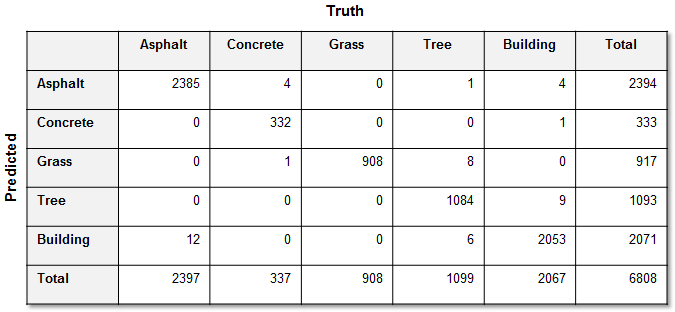ENVIConfusionMatrix::UserAccuracy
The UserAccuracy function method returns a user accuracy value. The result is an array with one value per class.
User accuracy is the probability that a value predicted to be in a certain class really is that class. The probability is based on the fraction of correctly predicted values to the total number of values predicted to be in a class.
In the example confusion matrix, user accuracy is computed as follows:
Asphalt: 2385 / 2394 = 0.996
Concrete: 332 / 333 = 0.997
Grass: 908 / 917 = 0.99
Tree: 1084 / 1093 = 0.992
Building: 2053 / 2071 = 0.991

Example
The code example below evaluates classifications using a confusion matrix.
PRO EvaluateClassificationUsingConfusionMatrix
COMPILE_OPT IDL2
; Start the application
e = ENVI()
; Open an input file
File = Filepath('qb_boulder_msi', Subdir=['data'], $
Root_Dir=e.Root_Dir)
Raster = e.OpenRaster(File)
File2 = Filepath('qb_boulder_roi.xml', Subdir=['data'], $
Root_Dir=e.Root_Dir)
Rois = envi.OpenROI(roiFile)
; Get training statistics
StatTask = ENVITask('ROIStatistics')
StatTask.INPUT_RASTER = Raster
StatTask.INPUT_ROI = Rois
StatTask.Execute
; Get the task from the catalog of ENVITasks
Task = ENVITask('MahalanobisDistanceClassification')
; Define inputs
Task.INPUT_RASTER = Raster
Task.COVARIANCE = StatTask.Covariance
Task.MEAN = StatTask.Mean
Task.CLASS_PIXEL_COUNT = StatTask.Roi_Pixel_Count
Task.CLASS_NAMES = [Rois[0].name, Rois[1].name, Rois[2].name]
Task.CLASS_COLORS = [[0,0,255], [0,255,0], [255,0,0]]
; Run the task and display the result
Task.Execute
ClassRaster = Task.OUTPUT_RASTER
View = e.GetView()
Layer = View.CreateLayer(ClassRaster)
; Add the output to the Data Manager
envi.Data.Add, ClassRaster
; Calculate the confusion matrix
ConfusionMatrix = ENVICalculateConfusionMatrixFromRaster(ClassRaster, Rois)
; Print results
Print, 'Confusion Matrix:'
Print, ConfusionMatrix.Confusion_Matrix
Print, 'Errors of commission: '
Print, Transpose([[ConfusionMatrix.Column_Names+': '], [(ConfusionMatrix.CommissionError()).ToString()]])
Print, 'Errors of omission: '
Print, Transpose([[ConfusionMatrix.Column_Names+': '], [(ConfusionMatrix.OmissionError()).ToString()]])
Print, 'Overall accuracy: ', ConfusionMatrix.Accuracy()
END
Syntax
Result = ENVIConfusionMatrix.UserAccuracy([, ERROR=variable])
Return Value
This function method returns the user accuracy value from the confusion matrix.
Arguments
None
Keywords
ERROR (optional)
Set this keyword to a named variable that will contain any error message issued during execution of this routine. If no error occurs, the ERROR variable will be set to a null string (''). If an error occurs and the routine is a function, then the function result will be undefined.
When this keyword is not set and an error occurs, ENVI returns to the caller and execution halts. In this case, the error message is contained within !ERROR_STATE and can be caught using IDL's CATCH routine. See IDL Help for more information on !ERROR_STATE and CATCH.
See Manage Errors for more information on error handling in ENVI programming.
Version History
|
ENVI 5.4 |
Introduced |
API Version
4.2